Our Vacation in India
Udaipur
We arrived at the Bandra train station, in the so-called suburbs of Mumbai, with what our driver thought was an absurdly long time to spare. We ended up making our train by about two minutes.
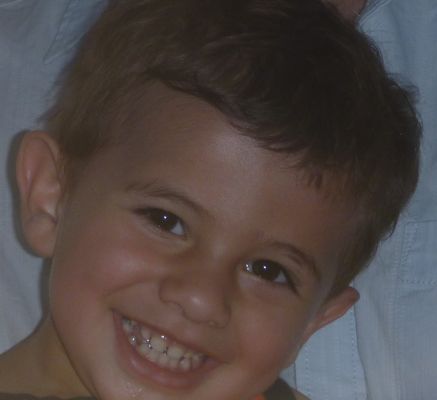
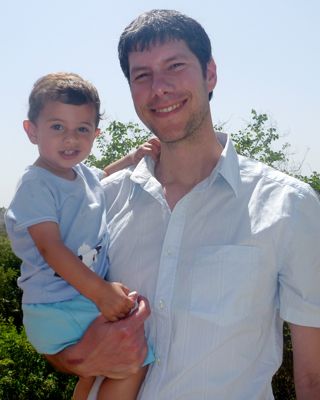
In the meantime, we thanked our driver and loaded up outside the car: I wore Marcus, now asleep, in the sling, and had our small backpack and my shoulder bag/pocketbook/diaper bag on; Robert got our two duffel bags, wheeling them when he could and carrying them when he had to.
We had bought our train tickets ahead of time, back in Boston, and that was a whole disorienting experience in itself; I think it took me about six hours to book the trains, between researching which train to take, figuring out which days it runs, finding hours when the Indian rail website was open (yes, the website closes), having password problems on the site, figuring out the different classes on the trains, double-checking the stations and dates, realizing that my name was unacceptably long and must be chopped off to prevent the site from crashing, and then having credit card and bank card verification problems—one PIN had the wrong number of digits, one card wasn’t recognized by Indian banks, one card shut itself down out of fraud protection, etc. We ended up buying them through Cleartrip, which was ultimately significantly better than the main Indian rail site in terms of outcomes (at least we were able to actually buy the tickets this way, after all), but not much better in terms of experience. So now, print-outs of our tickets in hand, all we had to do was figure out which platform our train was on, get over there, figure out which car we were in, get in, figure out which seats were ours, and sit down.
The station was massive, and massively crowded. Families camped out all over the lobby and platforms. Crowds of men stood against the walls talking and staring at us. In the thousands of people in this station, Robert, Marcus, and I definitely stuck out. Quite likely we were the only Westerners on our train—we certainly were the only obviously non-Indians I saw in the entire station. Our train didn’t have first class air conditioned seats, so we booked second class air conditioned, which was actually very nice when we finally found it. The seats weren’t expensive—all of our train tickets for the whole week ended up being less than $100, and kids under five are free and don’t even require a ticket (which is good, because we weren’t able to figure out how to book a kid’s ticket on the websites)—yet they were by far the most expensive seats on the train. On the entire train, of 32 cars, there were only two air-conditioned cars: our second-class, or two-tier AC, and a third-class, or three-tier AC. After a couple trains, we got good at trying to spot our car by scanning the windows of the cars passing by—the non-AC cars have open windows with bars on them (I felt nervous and thought they were too Holocaust-like, but Robert assured me that the bars in this case “were meant for the opposite”—i.e., to prevent people from leaping onto the trains), and the rare AC cars (always in a random order, unfortunately) actually had glass windows.
In the station, there were no signs, no boards saying what train left what platform when, no official people or obvious way to even begin to find that information. Two very persistent boys kept trying to take the duffel bags from Robert and lead us deeper into the station, saying “Very far! Very far!” Yes, in retrospect we realized that they were right, but at the moment, we just refused all help. I found a bulletin board that looked promising, but it just displayed the wait-listed ticket holders. Robert left the bags near me and went to try to investigate. He finally found an office with three lackadaisical officials who told him that we wanted to go to platform 16. Let’s reiterate that: Our train was on platform 16. We entered on platform 1. This meant we had to walk the entire length of the very crowded platform, snaking around the people sitting and lying down, watching the dogs running on and off the tracks and the men urinating on the tracks, and then climb the stairs at the end of the platform (maybe 2-3 flights high), walk the width of seven platforms, then climb down the stairs, and then walk the length of that platform again. There was our train, but where was our car? I started asking people, “Excuse me, where is second class?” but got nothing but blank stares. “Air-conditioned cars? AC? 2A” Nothing. Blankness. Robert and I were getting a little panicky by now, and Marcus had woken up and wasn’t quite sure what was going on. Someone finally said our car was all the way at the other end of the platform, so we started walking—now in haste, almost running—back down the platform one last time. Finally we got on our car, with a good two minutes to spare.
From our first moment in Mumbai traffic, to the constant din of horns (delivery trucks, colorfully labeled “Goods Carriers,” have to carry the slogan “Horn OK Please” by law, meaning that people should honk at them—and they honk back), to the smoky cities and the crowded train station, yes, we realized we’re not in Kansas (New York?) anymore. We would have loved to have collapsed in our seats, but we had to find them first. Apparently we were the last two seats booked in this car, so we didn’t have seats together. Robert got very panicky now, and finally got people—all of whom took the whole “assigned seat” thing a lot less seriously than we did—to move around to let us go together.
The car was subdivided into compartments meant for four people on one side of the aisle and two on the right; you could draw a curtain over each of the two side berths (one top and one bottom) individually if you wanted, or over the compartment for four people entirely. The compartment we ended up in seemed relatively social and didn’t want to use the curtains. An elderly couple with really no English had the window seats facing each other at left, then me and Marcus next to the elderly woman and a middle-aged man next to the elderly man. Technically, two of the four of us had tickets for the top berths, but no one really seemed to keep track of who had which berth, though a conductor did come around, squint at our print-outs, and check our names off a very long dot-matrix-printed list, where they were transliterated into Hindi for convenience. Robert sat across the aisle on one of the two seats there, facing a twenty-something man with an MBA, a job in international finance, and decent English. He and the middle-aged man were pretty talkative, and with the middle-aged man translating for the elderly couple, we all had a nice conversation.
The couple were Jain, which meant they needed to eat their vegetarian before sunset, so they broke out their tiffins of packed food on the early side. They shared some of their food with us, including chapatis, a dal, spicy popcorn, mango pickles, and an incredibly yummy cooked-milk sweet paste of some kind. The middle-aged man pulled out a chapati too, and said he bet his wife’s chapati was better (it was), so we took out some of our Crawford Market mangoes and my trusty Swiss Army knife and started slicing up mangoes and handing them around the compartment.
When Marcus woke up, he was very happy to walk up and down the aisle, throw out trash, and people-watch, but he slept for a long part of the trip. Robert got a cup of chai from the chai-walla who walked up and down the aisles, and exclaimed loudly when he burnt his fingers through the thin plastic cup. Everyone in the compartment laughed at him. He then tried to buy a sandwich from the sandwich-walla, but discovered that the guy wouldn’t make change for a hundred-rupee bill, and we were all out of small bills/coins (this would actually become an ongoing theme this trip). Again, everyone laughed, but the finance guy took pity on him and bought him the twenty-rupee (overpriced, we later learned) sandwich (cucumbers and tomato on white bread with spicy paste, quite nice). Finance guy got off at a midway station, and a former literature student got on. With all three men in our compartment, we talked about books, families, culture, banking, Hilary, and Obama, and we had a great time. When someone came around taking dinner orders (veg only), we ordered one, and after the next stop it was delivered. At that point Robert was walking somewhere else in the car with Marcus, so I just flat-out told the guy I had no smaller bill and he had to make change. Grumbling a lot, he left with my hundred and finally came back with change.
At one point, I told Robert to investigate the bathroom—I was told that there would be a western-style toilet (i.e., a toilet and not just a hole with footprints) in each of the air-conditioned cars. He had gone to the bathroom and just found the Indian-style toilet, but upon investigating he did find the western one. In fact, he found a conductor who seemed so excited to finally have a westerner who was actually going to use the toilet that he personally escorted him there in a very enthusiastic way. Robert came back, reporting that it was very clean and smell-free (a combination of being almost entirely unused, as far as we could tell, and letting all the waste flow freely over the tracks—signs asked you please not to use the toilet while in a station), but had no toilet paper. I assured him I could work around that, and so I passed off Marcus to him and made my way to the toilet. Robert had neglected, though, to mention the dozen Indian men standing smoking right against the door to the toilet—it was a bit disconcerting to go through them, but the experience was doable
Back in our compartment, it turned out that literature guy did not have a confirmed ticket and sort of wasn’t even supposed to be on this train, as far as we could tell. As though to serve him right, another man sat literally on his lap in the single seat. Literature guy craned his neck around the man and kept talking. No one but us seemed to think any of this was odd. By now, though, it was dark, and we were almost at Ahmedabad, where the train ended, so we started gathering our things (and our now-sleeping-again baby) together to get off the train.
At Ahmedabad we encountered another large, crowded station. Robert, who was not overly impressed by the train accommodations, was again not thrilled with the station. His reaction was ironic, though, since before we left—when I insisted on booking the fanciest class on every train we took—he kept complaining, “I want to travel with real Indian families! I don’t want to be in some sort of price-segregated American-tourist-only car!” Of course, in reality, we were quite possibly the only Americans on the whole train. We did see one other pale-skinned couple, two women backpackers, in Ahmedabad, but that was it.
Our literature friend told us where we could get something to eat in the station and where our next train would be, so we ventured toward the station restaurant to while away our hour and a half in between trains. Marcus was again sound asleep in the sling as we trooped down the platform, up the stairs, across the walkway, down the stairs, and into the small fast-food-like restaurant Comesum. There was something complicated about ordering that involved standing inside to read the menu, stepping outside to order and pay, bringing the food ticket back inside, then going back outside to wash your hands at a designated sink before coming back in to sit down and eat. I just sat at a table with Marcus and our bags and watched Robert go through these intricate steps. We ate a basic non-veg thali, and while it was far from the best meal we ate in India, it was decent, and for about $1, far more than decent.
There were lots of rural people and villagers in this station, judging from the way the people and clothes looked different than in Mumbai. Robert and I and Marcus attracted lots of stares, of course, but I think my sling also attracted its share. At one point, one woman with three kids under the age of four clearly turned to her husband and said in whatever language they spoke, “That! I want that! Get me one of those, you idiot!”
We made our train in a rush, once again having trouble finding our car on the platform, but a slightly less hectic rush than earlier in the day. This train ran on a different gauge track and so it was about 25% narrower than the other train—there we just the aisle and then a compartment for four people. We shared our compartment with two 30-something brothers, originally from Udaipur but now living south of Ahmedabad in Surat for business and going back home for a family funeral. Marcus and I took the bottom bunk under Robert, and the older brother slept across from me and made his younger brother take the top bunk over him. Marcus and I fell asleep immediately, using my linen sling and my long wrap (which I brought both as a spare carrier, in case anything happened to my sling and mei tai, and also precisely for this purpose) as a blanket, because the blankets and pillows provided smelled uncomfortably of mothballs. Robert said he was too cold in the air conditioning, and rolled himself up in the mothballed blankets anyway.
Marcus and I woke up at six in the morning, about two hours before our train was due to arrive, and watched out the window as it grew brighter and brighter outside. We saw camels, cows, pigs, goats, and bulls in people’s front yards. We saw people squatting with their backs to the train tracks relieving themselves. We passed some small stops that could hardly even be called “stations,” where the train paused for just 3-5 minutes and people would run off the train to a pump to fill their water bottles or to buy chai from a man standing there with a kettle. Robert finally got up—he hadn’t slept well or really at all, he said—and took Marcus to the door of the train (and, when someone who spoke English and appointed himself to look after Robert said the stop was long enough) the funny little rural platforms themselves, looking at other babies, buying chai, and just watching everything. When the brothers woke up—earlier than the older one wanted, but Marcus, though not throwing a fit or anything, was in cheerful good spirits and was not possible to silence—they washed up at one stop and then came back and played ball with Marcus in our compartment until the train rolled into Udaipur.
For me and baby, then, the train was a fabulous experience and a good night’s sleep all in one—less so for Robert.
In Udaipur we were met at the (small, small, small in comparison) train station by the hotel car and driver—clearly the fanciest mode of transportation around. Cold towels and cold water bottles greeted us in the car, and rose iced tea in the lounge when we arrived at the hotel before again doing the check-in process and paperwork in our own room.
Udaivillas is clearly a gorgeous, service-oriented (with 10 staff to each guest, at least at this time of year, “service-oriented” is indeed an understatement) hotel. We stayed just one night, but we checked in at 8:00 in the morning and checked out at 9:30 at night the next night, so essentially two full days and our one night.
Below: our hotel, Udaivillas
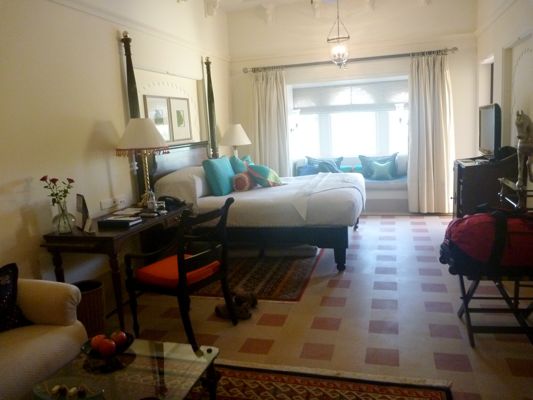
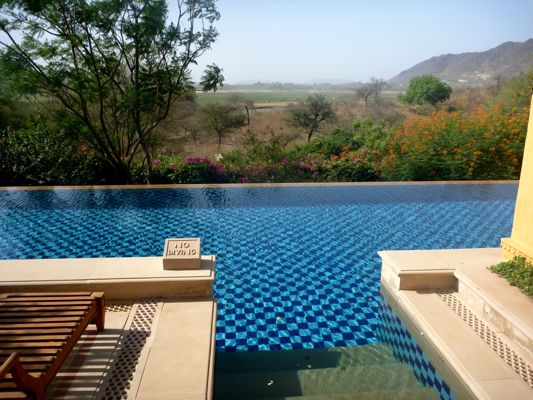
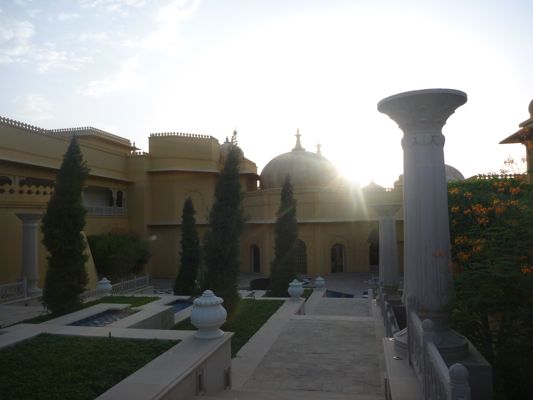
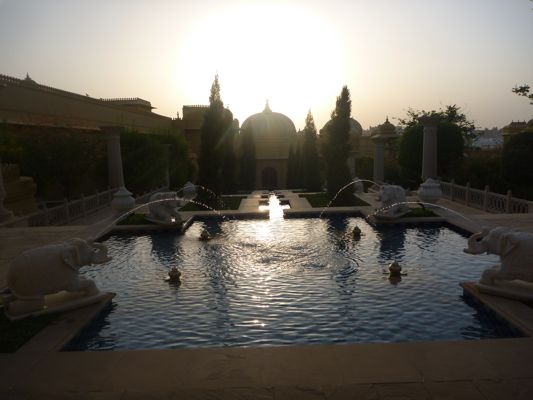
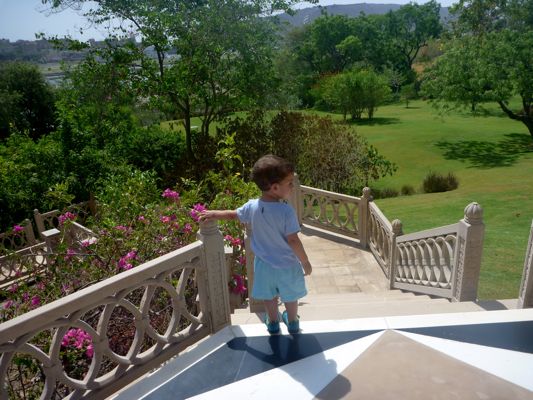
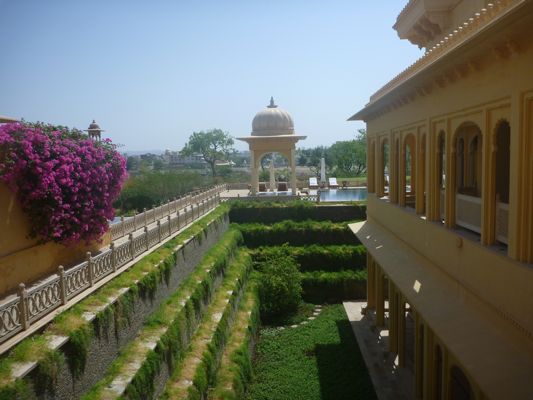
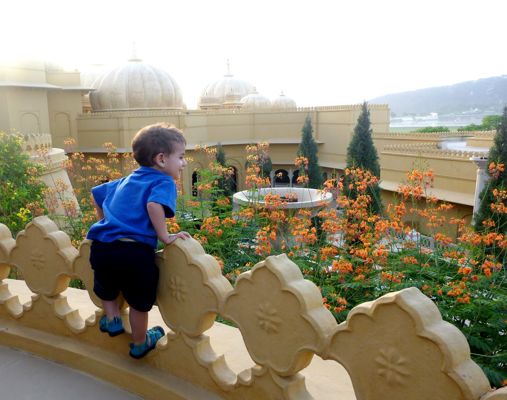
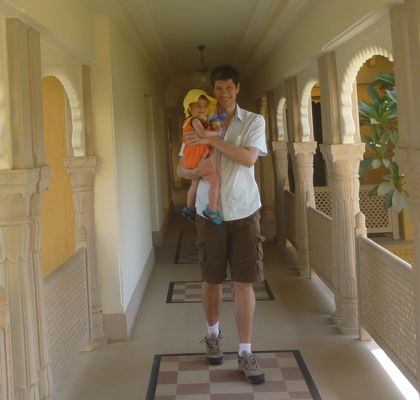
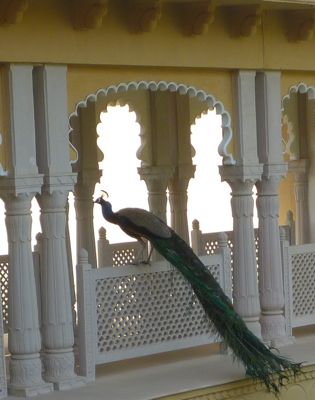
After quickly washing up, we went straight to breakfast, where we had dosas and uttapam (a rice and dal-based pancake with tomatoes and onions and cilantro—my new favorite breakfast food), each of which came with a basket of breads, pastries, and muffins, toast and jam, sliced fruit, and chutneys. We also had a beautiful fresh-squeezed mango juice and a sweet yogurt lassi.
Back in our room, we swam in the semi-private pool; our room, and the other eleven in its row, opened onto a private courtyard, which then opened onto a private balcony, which had steps down into a pool that ran the length of those rooms, widening out at the corners into round pools with seats. Our room was on the animal preserve side of the hotel, so we saw lots of birds around as we swam. Marcus tasted the water and declared it delicious—he kept trying to dunk his head under for just one more swallow.
After showers and a snack of the mangoes that the hotel had left in our room, we all took a nap through the hottest part of the day, getting up and dressed in time to leave for sightseeing around 4:30.
We took the hotel car and driver into town, where we walked around the fountain gardens along with some other families, drove by the almost dry man-made lake (the monsoons usually fill it, but the last “good” monsoon was in 2006, so everyone was very hopeful for this monsoon to bring back the beauty of the lack), stopped at the School of Art, where we learned about the miniature painting style of the area using natural colors from local stones, and then went to the Monsoon Palace, which the king built up on a hill to watch the monsoon clouds traveling along the valley below.
We looked at the view, watched the monkeys, played on the grass, enjoyed the now somewhat cooler temperatures, and chatted with some other Indian families also waiting for sunset.
Below: Monsoon Palace near sunset
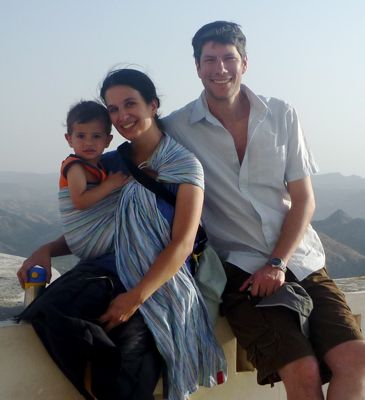
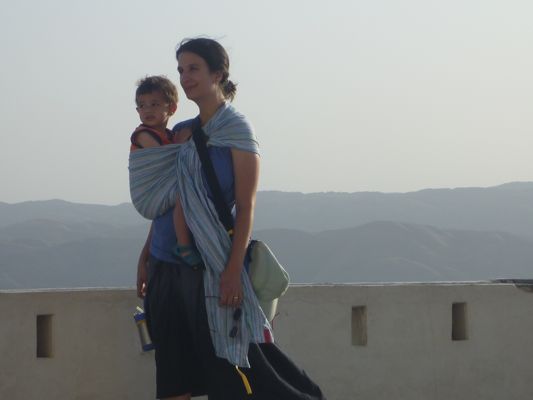
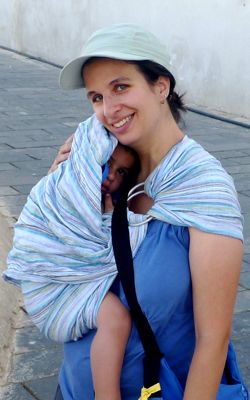
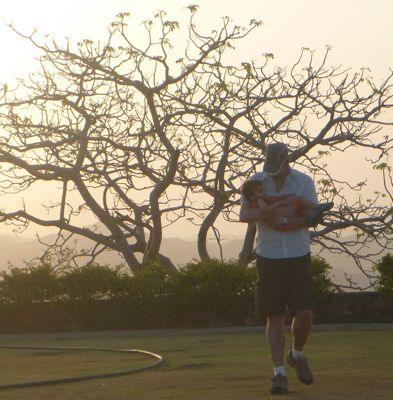
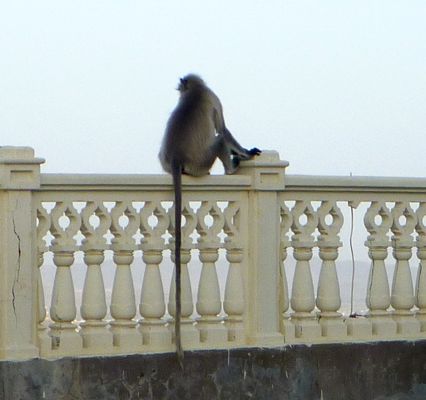
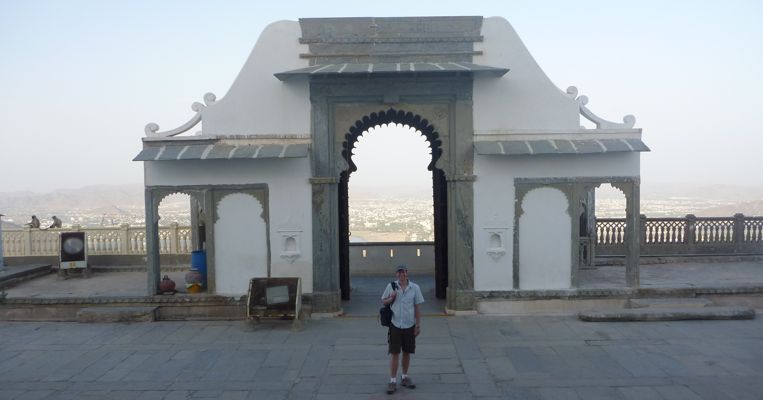
After the sunset, we drove back down the mountain and the car dropped us at the Ambrai restaurant in town, with a great view of the Lake Palace and City Palace. Marcus slept in the sling throughout the entire candlelit dinner of chicken tikka masala (again, trying to see how the dishes we normally order at home stacked up over here), Rajasthani graham flour dumpling special, and gulab jamun. It was a lovely, quiet, peaceful meal, and here was where we saw all the other Western tourists—more than we’d seen in total since arriving in India, actually.
Below: the view from dinner (sleeping baby and Lake Palace)
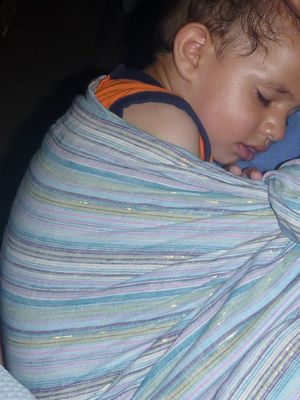
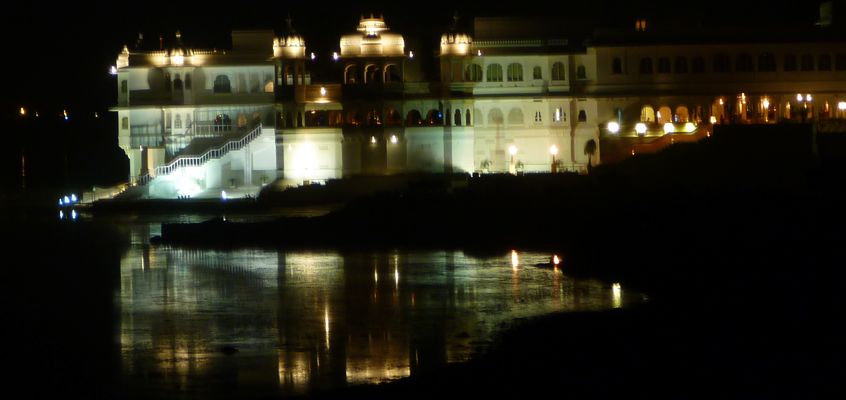
We took a tuk-tuk (auto rickshaw) back to the hotel afterward—what an exciting, fun ride! We were eye-to-eye with everything in the city, and Marcus woke up and enjoyed the ride too. Back at the hotel, we went swimming in our pool (again, deserted except for us, just like in the morning) in the dark before going to bed.
The bed was extremely comfortable, and I slept great except for being disturbed at a couple points by what I thought was the yowling of cats.
On Friday we woke up at 6:00 and had a nice walk around the grounds before another excellent breakfast. I asked Robert about the cats as we were walking around, because I hadn’t seen any cats at all, yet I’d heard them all night long. He laughed at me, and pointed out a peacock wandering the garden. Apparently, peacocks yowl. A lot. Who knew?
At breakfast, Marcus ate an entire cup of coconut chutney, slowly and steadily. We walked to the hotel gate and then took another auto rickshaw to the City Palace, where of course we were early. Indian men took cellphone pictures of us and of baby as we waited on the steps of the ticket booth, but we were among the first people inside when the palace did in fact open at 9:30.
We walked around, with Marcus sleepy in the mei tai but not actually asleep. It was okay, but the palace was quite run-down and not very well preserved—I’m not sure I would bother with it if I’d known that.
Afterward, we took a tuk-tuk ride around the city and lake, stopping a few times to take pictures, and then back to the hotel for lunch (an Indian cheese and veggie wrap and shrimp goan curry). Lunch was great. Marcus shoveled in rice as though there was no tomorrow, and then also devoured a number of small fried mashed-potato patties in the shape of smiley faces that the chef sent out for him. Everyone at the hotel loved baby, and kept trying to take him away to show him this or that or bring him into the kitchen, etc., but he was a little untrusting, and while he accepted their offerings of food, he preferred to stay close by, which of course was just fine with us.
We took another lovely swim after lunch, with much gazing over the side of the pool to see peacocks on the ground or in the trees nearby, and then another nap, before heading over to the hotel’s animal preserve around 6:00 in the evening. Marcus had slept through the animal feeding, but we still could see the Indian spotted deer and wild boar, and of course the peacocks, even though it was getting dim. Baby’s a huge fan of the peacocks—“Boo!” (Bird) he would say, pointing. Then, “Boo!” pointing at another.
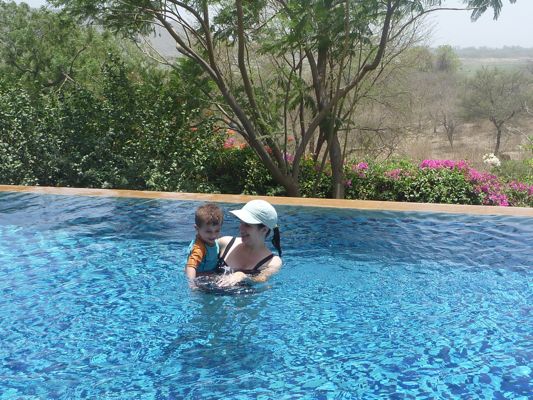
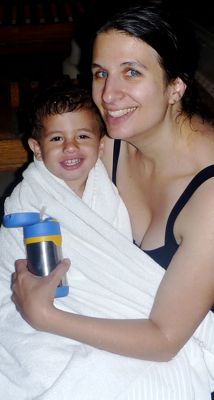
We watched the animals for a long time, as it started getting dark, only taking time out to go into a small museum right on the edge of the hotel property—an 1850s building built by the Maharana as a hunting lodge; he would come down from the Monsoon Palace, hunt, then rest and dine in this little house and go back up. The building’s caretaker, Roop Singh Ji, with a fabulous white handlebar moustache, showed us around—he’d been there for 41 years as caretaker, and before that he’d been in the service of the king. With no English, but lots of character and animated signing, and some questions and squinting on our part, he communicated that he knew the king personally and felt honored to show off these buildings. He showed us a painting of the 1850s king on a wall—one of those trick-perspective paintings where if you stand on one side the figure’s hand appears to point toward you and he seems to look right at you, but the eyes follow you—and the hand points right at you—if you cross to the other side. We also saw a room painted on all four walls and the ceiling with a mural of the surrounding area—the exact scenery, slightly stylized, that you’d see if you looked out the windows around you, complete with birds, tigers, and other wildlife. Roop Singh Ji told us how the king would have tigers fight wild boar for sport, outside the very house we were in, with tiny windows at eye-level to look down at the fight; when he was a boy of ten, in the service of the king, he saw the last of those fights right here. This house, and its paintings, was perfectly preserved—pristine and lovely—and far better to visit than the City Palace.
Below: at the wildlife sanctuary
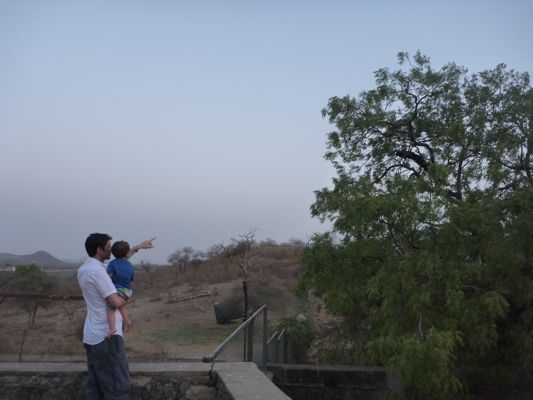
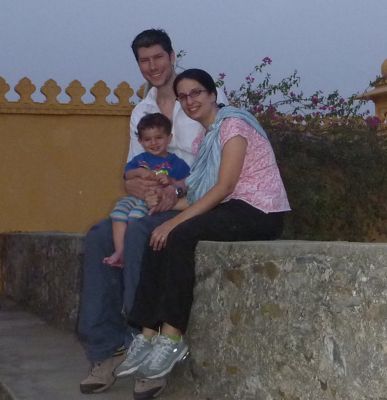
Dinner, on the hotel terrace in front of live music and dancers, was excellent—Marcus slept on my lap throughout most of the meal. Robert ordered the chef’s special fixed price menu with a Bengali fish fry, sweet and spicy lamb, and a mango yogurt pudding dessert (amrakhand). I ordered another of those Rajasthani dumpling dishes, potato-based, this time, and the chef sent me something to eat along with every one of Robert’s courses—a small tomato soup, a mango sorbet, a khulfi—each of which were delicious. We hustled a little though the meal, finishing at 9:15, and checked out, putting our bags in the lobby and taking the hotel car back to the train station and saying goodbye to the most amazing hotel we have ever stayed at.
We saw now that the Udaipur train station was in fact very organized, and even had a high-tech sign, plus people in an office to ask questions of. Even more shockingly, our train was right there, right on the first platform, so we were able to board with only the problem of trying to find our car.
This train was another meter gauge (narrow gauge) train, like the second one we’d taken on the way over, but this one actually had exactly one first class AC compartment—ours. It had two bunks, one over the other, facing a plain wall, and a door with a lock on it, pillows in plastic wrap (no mothball smell), and a high-tech “occupied” indicator for the bathrooms (both Indian-style and Western-style) right in our compartment. It was quite deluxe, but kind of isolating, since we didn’t come into contact with anyone else, having the compartment all to ourselves. In any case, Marcus and I fell asleep before the train even left the station, and once again, Robert took the top bunk and slept fitfully.